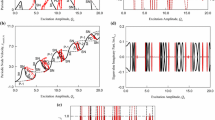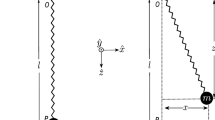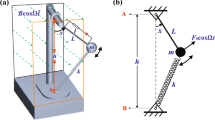Abstract
This paper is concerned with the chaotic dynamics of a rotating pendulum system with bistable characteristics subjected to a viscous damping and a harmonic forcing. As a prototype of the single-degree-of-freedom system with bistable characteristics, this pendulum system exhibits a transition from smooth to discontinuous dynamics by changing a geometrical parameter. The dynamic behaviors of the unperturbed system with irrational nonlinearity bear significant similarities to the coupling of a simple pendulum and the smooth and discontinuous (SD) oscillator with the coexistence of the standard homoclinic orbits of Duffing type and pendulum type and the coexistence of the nonstandard homoclinic orbits of SD type and pendulum type in the smooth and discontinuous case, respectively. For the perturbed smooth system, we present an approximate technique to analytically obtain the lower bound line for horseshoes chaos arising from the homoclinic orbits of Duffing-type and Pendulum-type tangling, which overcomes the natural difficulties of solving the analytical expression of the homoclinic orbits and calculating the complicated Melnikov integrals. The chaotic thresholds of the perturbed discontinuous system are calculated by applying the numerical technique due to its non-smooth feature. Numerical simulations are carried out to certify the chaotic thresholds, which show the efficiency of the proposed techniques and demonstrate the predicated chaotic motions. Finally, different types of chaotic motions are illustrated via the cylindrical phase portraits. The contribution of this study is also helpful for exploring the dynamical behaviors of the complex nonlinear dynamical system containing the standard homoclinic or heteroclinic orbit in terms of the quantitative calculation.

















Similar content being viewed by others
References
Parks, H.V., Faller, J.E.: Simple pendulum determination of the gravitational constant. Phys. Rev. Lett. 105, 110801 (2010)
Albert Luo, C.J.: Resonance and Bifurcation to Chaos in Pendulum. Higher Education Press, Beijing (2017)
D’Humieres, D., Beasley, M.R., Huberman, B.A., Libchaber, A.: Chaotic states and routes to chaos in the forced pendulum. Phys. Rev. A 26(6), 3483–3496 (1982)
Zayas, V.A., Low, S.S., Mahin, S.A.: A simple pendulum technique for achieving seismic isolation. Earthq. Spectra 6, 317–333 (1990)
Kim, Y., Kim, S.H., Kwak, Y.K.: Dynamic analysis of a non-holonomic two-wheeled inverted pendulum robot. J. Intell. Robot. Syst. 44, 25–46 (2005)
Whitaker, R.: Types of two-dimensional pendulums and their uses in education. Sci. Educat. 13, 401–415 (2004)
Farrugia, A.: The regulatory pendulum in transfusion medicine. Transf. Med. Rev. 16, 273–282 (2002)
Awrejcewicz, J., Kudra, G.: Modeling, numerical analysis and application of triple physical pendulum with rigid limiters of motion. Arch. Appl. Mech. 74, 746–753 (2005)
Awrejcewicz, J., Sendkowski, D., Kazmierczak, M.: Geometrical approach to the swinging pendulum dynamics. Comput. Struct. 84, 1577–1583 (2006)
Xu, X., Wiercigroch, M.: Approximate analytical solutions for oscillatory and rotational motion of a parametric pendulum. Nonlinear Dyn. 47, 311–420 (2007)
Das, S., Wahi, P.: Initiation and directional control of period-1 rotation for a parametric pendulum. Proc. R. Soc. A 472, 20160719 (2016)
Zhang, H., Ma, T.: Iterative harmonic balance for period-one rotating solution of parametric pendulum. Nonlinear Dyn. 70, 2433–2444 (2012)
Awrejcewicz, J., Kudra, G., Wasilewski, G.: Chaotic zones in triple pendulum dynamics observed experimentally and numerically. Appl. Mech. Mater. 9, 1–17 (2008)
Kazmierczak, M., Kudra, G., Awrejcewicz, J., et al.: Mathematical modelling, numerical simulations and experimental verification of bifurcation dynamics of a pendulum driven by a dc motor. Eur. J. Phys. 36(5), 13 (2015)
Ji, J.C., Chen, Y.S.: Bifurcation in a parametrically excited two-degree-of-freedom nonlinear oscillating system with 1:2 internal resonance. Appl. Math. Mech. 20, 350–359 (1999)
Krasilnikov, P., Gurina, T., Svetlova, V.: Bifurcation study of a chaotic model variable-length pendulum on a vibrating base. Int. J. Non-Linear Mech. 105, 88–98 (2018)
Albert Luo, C.J., Min, F.H.: The chaotic synchronization of a controlled pendulum with a periodically forced, damped Duffing oscillator. Commun. Nonlinear Sci. Numer. Simulat. 16, 4704–4717 (2011)
Leven, R.W., Koch, B.P.: Chaotic behaviour of a parametrically excited damped pendulum. Phys. Lett. A 86, 71–74 (1981)
Stachowiak, T., Okada, T.: A numerical analysis of chaos in the double pendulum. Chaos Solitons Fract. 29, 417–422 (2006)
Kapitaniak, M., Czolczynski, K., Perlikowski, P., Kapitaniak, T.: Synchronization of clocks. Phys. Rep. 517, 1–69 (2012)
Najdecka, A., Kapitaniak, T., Wiercigroch, M.: Synchronous rotational motion of parametric pendulums. Int. J. Non-Linear Mech. 70, 84–94 (2015)
Yang, C.C.: Synchronizations of rotating pendulums via self-learning terminal sliding-mode control subject to input nonlinearity. Nonlinear Dyn. 72(3), 695–705 (2013)
Wojna, M., Wijata, A., Wasilewski, G., Awrejcewicz, J.: Numerical and experimental study of a double physical pendulum with magnetic interaction. J. Sound Vib. 430, 214–230 (2018)
Nana, B., Yamgoué, S.B., Tchitnga, R., Woafo, P.: Dynamics of a pendulum driven by a DC motor and magnetically controlled. Chaos Solitons Fract. 104, 18–27 (2017)
Awrejcewicz, J., Kudra, G., Wasilewski, G.: Experimental and numerical investigation of chaotic regions in the triple physical pendulum. Nonlinear Dyn. 50(4), 755–766 (2007)
Olejnik, P., Awrejcewicz, J.: Coupled oscillators in identification of nonlinear damping of a real parametric pendulum. Mech. Syst. Signal Process. 98, 91–107 (2018)
Anh, N.D., Matsuhisa, H., Viet, L.D., Yasuda, M.: Vibration control of an inverted pendulum type structure by passive mass–spring–pendulum dynamic vibration absorber. J. Sound Vib. 307(1–2), 187–201 (2007)
Wu, S.T., Siao, P.S.: Auto-tuning of a two-degree-of-freedom rotational pendulum absorber. J. Sound Vib. 331, 3020–3034 (2012)
Mahmoudkhani, S.: Improving the performance of auto-parametric pendulum absorbers by means of a flexural beam. J. Sound Vib. 425, 102–123 (2018)
Han, N., Cao, Q.J.: Global bifurcations of a rotating pendulum with irrational nonlinearity. Commun. Nonlinear Sci. Numer. Simulat. 36, 431–445 (2016)
Ueda, Y.: Randomly transitional phenomena in the system governed by Duffing’s equation. J. Stat. Phys. 20, 181–196 (1979)
Lorenz, E.N.: Deterministic nonperiodic flow. J. Atmos. Sci. 20, 130–141 (2004)
Gleick, J., Hilborn, R.C.: Chaos, making a new science. Phys. Today 56, 79 (1998)
Yorke, L.J.A.: Period three implies chaos. Am. Math. Mon. 82(10), 985–992 (1975)
Melnikov, V.K.: On the stability of the center for time-periodic perturbations. Trans. Moscow. Math. 12, 1–57 (1963)
Awrejcewicz, J., Holicke, M.M.: Smooth and nonsmooth high dimensional chaos and the Melnikov-type methods. World Scientific, Singapore (2007)
Battelli, F., Palmer, K.J.: Chaos in the duffing equation. J. Differ. Equ. 101, 276–301 (1993)
Hou, L., Su, X.C., Chen, Y.S.: Bifurcation modes of periodic solution in a Duffing system under constant force as well as harmonic excitation. Int. J. Bifurcat. Chaos 29(13), 1950173 (2019)
Guckenheimer, J., Holmes, P.: Nonlinear Oscillations, Dynamical Systems, and Bifurcations of Vector Fields. Springer, New York (1983)
Kwekt, K.H., Li, J.B.: Chaotic dynamics and subharmonic bifurcations in a non-linear system. Int. J. Non-Linear Mech. 31(3), 277–295 (1996)
Awrejcewicz, J., Holicke, M.: Analytical prediction of stick-slip chaos in a double self-excited Duffing-type oscillator. Math. Probl. Eng. 834(6), 369–376 (2006)
Cao, Q.J., Wiercigroch, M., Pavlovskaia, E.E., Grebogi, C., Thompson, J.M.T.: Piecewise linear approach to an archetypal oscillator for smooth and discontinuous dynamics. Philos. Trans. R. Soc. A 366, 635–652 (2008)
Cao, Q.J., Wiercigroch, M., Pavlovskaia, E.E., Grebogi, C., Thompson, J.M.T.: Archetypal oscillator for smooth and discontinuous dynamics. Phys. Rev. E 74, 046218 (2006)
Zhang, W., Yao, M.H., Zhang, J.H.: Using the extended Melnikov method to study the multi-pulse global bifurcations and chaos of a cantilever beam. J. Sound Vib. 319(1–2), 541–569 (2009)
Han, Y.W., Cao, Q.J., Chen, Y.S., Wiercigroch, M.: A novel smooth and discontinuous oscillator with strong irrational nonlinearities. Sci. China-Phys. Mech. Astron. 55, 1832–1843 (2012)
Feng, J.J., Zhang, Q.C., Wang, W.: Chaos of several typical asymmetric systems. Chaos Solitons Fract. 45, 950–958 (2012)
Tian, R.L., Wu, Q.L., Xiong, Y.P., Yang, X.W.: Bifurcations and chaotic thresholds for the spring-pendulum oscillator with irrational and fractional nonlinear restoring forces. Eur. Phys. J. Plus 129, 85–223 (2014)
Zhang, X., Zhou, L.Q.: Melnikov’s method for chaos of the nanoplate postulating nonlinear foundation. Appl. Math. Model. 61, 744–749 (2018)
Ren, H.P., Zhou, Z.X., Grebogi, C.: Nonlinear dynamics in the flexible shaft rotating-lifting system of silicon crystal puller using Czochralski method. Nonlinear Dyn. 1–14, 771 (2020)
Nusse, H.E., Yorke, A.Y.: Dynamics Numerical Explorations. Springer, New York (1997)
Tian, R.L., Yang, X.W., Cao, Q.J., Wu, Q.L.: Bifurcations and chaotic threshold for a nonlinear system with an irrational restoring force. Chin. Phys. B 2, 136–147 (2012)
Hou, L., Chen, Y.S., Fu, Y.Q., Chen, H.Z., Lu, Z.S.: Application of the HB–AFT method to the primary resonance analysis of a dual-rotor system. Nonlinear Dyn. 88(4), 2531–2551 (2017)
Zhao, X., Chen, B., Li, Y.: Forced vibration analysis of Timoshenko double-beam system under compressive axial load by means of Green’s functions. J. Sound Vib. 464, 115001 (2020)
Hao, Z.F., Cao, Q.J.: The isolation characteristics of an archetypal dynamical model with stable-quasi-zero-stiffness. J. Sound Vib. 340, 61–79 (2015)
Sun, X.T., Wang, F., Xu, J.: Dynamics and realization of a feedback-controlled nonlinear isolator with variable time delay. J. Vib. Acoust. 141(2), 021005 (2018)
Wiercigroch, M., Najdecka, A., Vaziri, V.: Nonlinear Dynamics of Pendulums System for Energy Harvesting. In: Vibration Problems ICOVP. Springer, Netherlands (2011)
Acknowledgements
This work was supported by the National Natural Science Foundation of China (Grant Nos. 11702078, 11771115); the Natural Science Foundation of Hebei Province (Grant Nos. A2018201227, A2019402043); and the High-Level Talent Introduction Project of Hebei University (801260201111).
Author information
Authors and Affiliations
Corresponding author
Ethics declarations
Conflict of interest
The authors declare that they have no conflict of interest.
Additional information
Publisher's Note
Springer Nature remains neutral with regard to jurisdictional claims in published maps and institutional affiliations.
Appendix
Appendix
When \(f_{0}=0\) and \(\omega =0\), the damping pendulum system can be written as
This study focuses on the rotating pendulum system with bistable characteristics which means that there exist five equilibria \(({x_{i},y_{i}})_{i=1,2,3,4,5}\) in the damping pendulum system satisfying \(|\rho |<1\) or
Then, the Jacobian matrix at equilibria \(({x_{i},y_{i}})_{i=1,2,3,4,5}\) can be expressed as
and
which leads to the characteristic equation
Two eigenvalues \(\varLambda _{1,2}\) can be derived by calculating the characteristic equation and written as
where
Then, we will explore the effect of nonnegative damping \(\xi \) on the equilibria \(({x_{i},y_{i}})_{i=1,2,3,4,5}\) based upon two eigenvalues. The detailed analysis is listed in the following.
(a) When \(\xi >0\) and \(\xi =0\), for the equilibria \((x_{1},y_{1})\), \((x_{2},y_{2})\) and \((x_{3},y_{3})\), there exist two unequal real roots
due to \(\Delta >0\) and \(K(x_{1,2,3})>0\). It is concluded that the equilibria \((x_{1},y_{1})\), \((x_{2},y_{2})\) and \((x_{3},y_{3})\) are saddle points.
(b) No damping: When \(\xi =0\), for the equilibria \((x_{4},y_{4})\) and \((x_{5},y_{5})\), there exists a pair of conjugate pure virtual roots
due to \(\Delta <0\) and \(K(x_{4,5})<0\). It is concluded that \((x_{4},y_{4})\) and \((x_{5},y_{5})\) are centers.
(c) Weak damping: When \(\xi ^{2}+4K(x_{4,5})<0\), for the equilibria \((x_{4},y_{4})\) and \((x_{5},y_{5})\), there exists a pair of conjugate virtual roots
due to \(\Delta <0\) and \(K(x_{4,5})<0\). Since the real part of the eigenvalues are less than zero, we conclude that \((x_{4},y_{4})\) and \((x_{5},y_{5})\) are stable focus points.
(d) Strong damping: When \(\xi ^{2}+4K(x_{4,5})>0\), for the equilibria \((x_{4},y_{4})\) and \((x_{5},y_{5})\), there exist two unequal real roots
due to \(\Delta >0\) and \(K(x_{4,5})<0\). Since two eigenvalues are less than zero, we conclude that \((x_{4},y_{4})\) and \((x_{5},y_{5})\) are stable node points.
(e) Critical damping: When \(\xi ^{2}+4K(x_{4,5})=0\), for the equilibria \((x_{4},y_{4})\) and \((x_{5},y_{5})\), there exist two equal real roots
due to \(\Delta =0\) and \(K(x_{4,5})<0\). It is concluded that \((x_{4},y_{4})\) and \((x_{5},y_{5})\) are stable degenerate nodes.
Rights and permissions
About this article
Cite this article
Han, N., Lu, P. & Li, Z. An approximate technique to test chaotic region in a rotating pendulum system with bistable characteristics. Nonlinear Dyn 104, 191–214 (2021). https://doi.org/10.1007/s11071-021-06274-w
Received:
Accepted:
Published:
Issue Date:
DOI: https://doi.org/10.1007/s11071-021-06274-w




